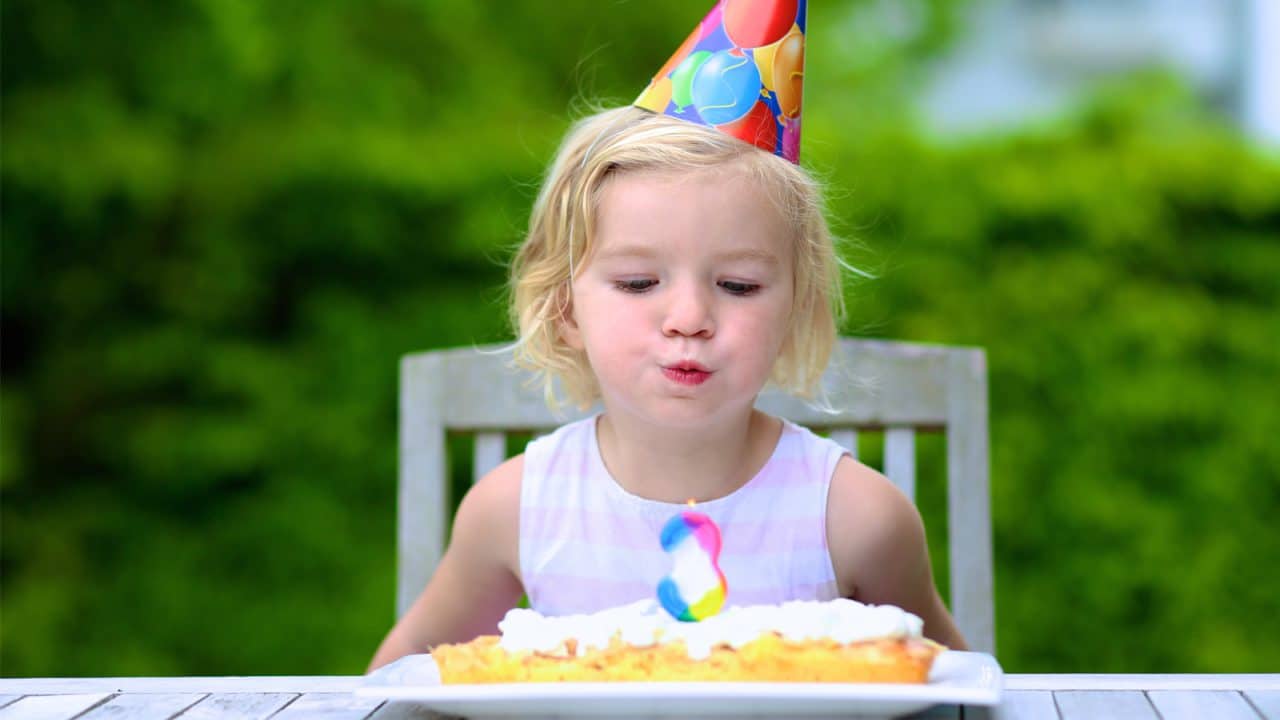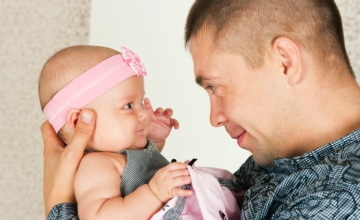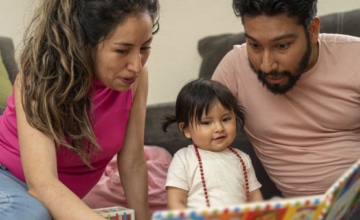There’s an old saying that with young children, “The days go slow, but the years go fast.” Browse the information and links below to see what your little one is experiencing and learning this month.
IN THIS RESOURCE
- What It’s Like for You
- What It’s Like for Your Child
- What to Expect From Your Child’s Development
- Did You Know…
- Spotlight on: Preparing for Preschool
- Let’s Play: Activities That Nurture Bonding and Learning
- What’s on Your Mind?
- Expert Reviewers
What It’s Like for You
Kate, mother of 3-year-old twins Liza and Petey, took a walk to the playground last week:
We got to the park and the kids took off, crawling up to the top of the climbing wall, jumping down from the top. They were pretending to be rocket ships, racing across the playground as fast as they could. Petey fell down and Liza was right there to see if he was okay, and then the two of them took off again. This time they were pretending to be horses so they started galloping around. Then up the slide and the two of them zoomed down the big one they used to be so scared of. All of a sudden it hit me just how much things have changed over the last 3 years. I remember coming here when they were just tiny babies. They’d sit in their strollers and just watch. And then they’d crawl around and eat dirt! When they were a little bigger, we’d swing them in the baby swings. Then they started toddling around on their own. But look at them now—running, climbing, talking, pretending. How did it happen so fast?
There’s an old saying that with young children, “The days go slow, but the years go fast.” Here at ZERO TO THREE, we are honored that you chose to share your child’s first years with us. As your family enters the next phase of life with an active and curious preschooler, we wish you all the best in your adventures to come. With your love, support, and guidance, your pint-sized trailblazer will lead the way to places you may have never dreamed of.
What It’s Like for Your Child
Cara and I were pretending to be birds. “Let’s put the nest over here,” I said. Cara grabbed the red striped blanket: “Okay, I’ll make the nest.” She carefully wound the blanket up in a circle and sat inside. All of a sudden, I felt upset—jealous and mad. I said: “I wanted that blanket. The red blanket is mine.” Cara looked upset. “No, it’s not. It’s mine! I made the nest so it’s mine.” I grabbed the red blanket and Cara started to cry. Mommy came in. I started to cry too because I thought I was going to get in trouble. Instead, Mommy said: “One blanket, two girls, what can we do?” She kneeled down and put her arms around us. “Maybe we need another blanket. I know a nice yellow one that will look great with the red.” I jumped up and shouted, “I know the one, I’ll get it! It’s on my bed.” I came back with the blanket and made my own nest. Then Cara and I ran around the room collecting blocks and laying them all over the floor. Cara pointed at the blocks and said, “Okay, all the worms are in the forest.” I curled up in the yellow nest: “Cara, you be the mommy bird. Tweet, tweet, I’m the baby bird. Feed me!” Cara ran to get a “worm” and “fed” me. I made gobbling sounds and said, “Yummy worm, Mommy!” Cara rubbed my head: “Now it’s night-night, baby bird!”
What Your Toddler Is Learning
Social-Emotional Skills:
- The joy of close friendships as the two girls enjoy their playtime together
- Conflict resolution skills as the girls resolve their disagreement with an adult’s help and without being hurtful to one another
- Empathy—when Cara gently rubs her friend’s head when she is pretending to be her mother
Language and Thinking Skills:
- Creative thinking when Cara suggests making a nest from a blanket
- Role-playing when the girls take on the roles and feeding preferences of birds
- Symbolic thinking skills when the girls can imagine that the blocks are worms and the blankets are nests
- Logical thinking skills when the girls take on the roles of baby and mother bird, and the baby tells the mother bird to feed her (making the logical connection that parents are responsible for providing meals to their children)
Physical Skills:
- Large motor skills (using arm and leg muscles) when the girls turn the blanket into nests and run around the room collecting and placing blocks
- Small motor skills (using the muscles in hands and fingers) when the girls pick the blocks up to eat them as worms
What to Expect From Your Child’s Development
As you read the chart below, keep in mind that development is not a race and that every child grows at her own pace and in her own way. Your child may develop skills faster or slower than indicated below and still be on track. If you have questions or concerns, talk with your child’s health care provider or other trusted professional.
Your Child’s Development From 30 to 36 Months
| What Your Baby Can Do | What You Can Do to Connect With Your Baby |
|---|---|
My body lets me do “big kid” stuff now! |
|
I may be able to:
|
|
I use language to express my thoughts and feelings. |
|
|
|
I am using my new thinking skills to solve problems. |
|
|
|
I can do so many things by myself! |
|
|
|
I am starting to notice similarities and differences in people. |
|
|
|
My friends are very important to me. |
|
|
|
Did You Know…
The average preschooler (aged 3 to 6) has one tantrum per day, and the tantrum lasts about 3 minutes?
What the Research Means for You
You’re not alone. All children “lose it” occasionally. But as children grow, parents sometimes question whether it’s normal for their preschooler to still have tantrums and wonder if they should seek help.
This research identified five key “worry” factors that may indicate a need to seek support and assistance from your child’s health care provider or a child development specialist. These professionals work with families to understand more about what triggers a child’s tantrums and how to help the child cope more effectively with his feelings. The five “worry” factors included:
- Aggression with violent, destructive behavior (frequent kicking, hitting, throwing, and breaking objects)
- Self-injurious behavior—when children purposefully hurt themselves during a tantrum
- Excessive frequency—tantrums on 10-20 days per month or more than five times per day
- Extended length—tantrums lasting more than 25 minutes
- Limited self-soothing skills—when children are unable to calm themselves without a lot of assistance
If you are seeing one or more of these symptoms in your preschooler, talk with your pediatrician, a child development specialist, or a mental health counselor who has experience with young children to see if there may be additional ways you can support your child.
Spotlight on: Preparing for Preschool
If your child is starting preschool or another group experience this fall, you may be approaching this major milestone with conflicting emotions. You’re probably excited about all the fun (you hope) your child will have and the new friends she’ll make. At the same time, you may feel a little sad that your baby is venturing out into the big world without you. These emotions are normal. Your child is also bound to have a host of feelings about this transition, feeling proud to be a big kid but at the same time worried about being separated from you and starting something unfamiliar.
Having Fun With Preschool Prep
There is a lot you can do in the weeks leading up to the big day. But try to keep your efforts low key. If you make too big a deal out of this milestone, your child may end up being more worried than excited. Here are some ideas to keep the focus on fun.
Use pretend play to explore the idea of preschool.
Take turns being the parent, child, and teacher. Act out common daily routines, such as saying good-bye to mommy and/or daddy, taking off his coat, singing songs, reading stories, having Circle Time, playing outside, and taking naps. Reassure your child that preschool is a good place where he will have fun and learn. Answer his questions patiently. This helps children feel more in control, which reduces their anxiety.
Read books about preschool.
There are many books about going to preschool available from the public library in your area. Choose several to share with your child over the summer before school starts. Talk about the story and how the characters are feeling. Ask how your child is feeling.
Make a game out of practicing self-help skills.
Games such as: unzipping her coat, hanging her coat on a hook, putting on her backpack, fastening her shoes. You might want to have a “contest” with your child to see how quickly she can put on her shoes. Or play “pretend school” and have her take off her coat, zip her backpack closed, and sit “criss-cross applesauce.” If your child will be bringing lunch, have her help you make a lunch, pack it up, and have a picnic together. This will give her the chance to practice opening her lunch box and unwrapping her sandwich—important skills for the first day!
Play at your new preschool.
Visit your child’s preschool together. Play on the school playground a few times before your child starts the program. These visits increase your child’s comfort with and confidence in this new setting.
Dealing with Worries
Your child may also have some questions or concerns about starting preschool, either before or after the program begins in the fall. Here’s what to do:
Listen to your child’s worries.
Although it’s tempting to quickly reassure your child and move on, it’s important to let your child know that his worries have been heard. No matter what they are, big or small, children’s concerns about preschool can significantly influence their experience there. Will you remember to pick him up in the afternoon? Will his teacher be nice?
Let your child know it’s normal to feel happy, sad, excited, scared, or worried.
Explain that starting something new can feel scary and that lots of people feel that way. It can be helpful to share a time when you started something new and how you felt. When you allow your child to share her worries, you can help her think through how to deal with them. For example, if she is worried about missing you, the two of you can make a book of family photos to keep in her cubby and look at when she is lonely.
Notice nonverbal messages.
As much as 3-year-olds may talk, most are not yet able to fully explain how they are feeling or what they are worried about. Your child may “act out” his worry by clinging more, becoming withdrawn, or by being more aggressive. Another common reaction as children take a big move forward in the transition to preschool is to actually move backward in other areas. For example, if your child is fully potty trained, she may start have toileting accidents. She may ask that you feed or dress her even though she can do these things by herself. It is natural to be frustrated or confused by this regressed behavior, and you may be concerned that if you do these things for her she won’t go back to doing them herself. In fact, letting children be “babied” in this way often leads to them returning to their “big kid” selves sooner. Remember that your child is facing—and managing—a big change in her life. She may need more support, nurturing, and patience from you while she makes this transition.
Saying a Good Good-Bye
Plan to stay a little while.
Staying for 15-30 minutes on that first morning can help ease the transition to preschool. Together, the two of you can explore the classroom, meet some other children, and play with a few toys. When you see that your child is comfortable, it is time to leave. If he is having a harder time getting engaged, you may want to ask your child’s teacher to stay with your child as you say good-bye so that when you leave, he can turn to another caring adult for support.
Keep your tone positive and upbeat.
Children pick up on the reactions of the trusted adults in their lives. So try not to look worried or sad, and don’t linger too long. Say a quick, upbeat good-bye and reassure your child that all will be well. Think about creating a special good-bye routine. For example, you can give your child a kiss on her palm to “hold” all day long. Or, the two of you can sing a special song together before you leave. Good-bye routines are comforting to children and help them understand and prepare for what will happen next.
Resist the rescue.
Try not to run back in to the classroom if you hear your child crying, as upsetting as this can be. This is a big change and your child may, quite understandably, feel sad and a little scared. But if you run back in, it sends the message that he is only okay if you are there. It may prolong your child’s distress and make it harder for him to adapt. Rest assured, teachers have many years of experience with helping families make the shift to preschool. Instead, you can wait outside the classroom for a few minutes to ensure that all is well, or call the school later in the morning to check in.
Let’s Play: Activities That Nurture Bonding and Learning
Name Hop
Gather together 15-20 pieces of paper. Neatly print your child’s name on 10 of the sheets. On the other pages, write a few names of family members or friends (Mommy, Daddy, Grammy Tommy, a pet’s name, etc.). Make a path on the floor with the word cards, mixing them all up. While she won’t be able to read the other names, you want her to begin to recognize her own name as different from the others. Show your child her name (or see if she can recognize it). Ask her if she can hop along the path you’ve made, stepping only on her name. Games like this develop literacy, language, balance, and coordination.
Outline Time
Cut open several brown paper bags and tape them together to make a sheet of paper as large as your child (you can also ask in the meat department of your grocery store for a 3-foot length of butcher paper). Ask your child to lay on the paper while you trace her outline with a marker. The two of you can decorate his outline with paint, markers, and crayons. You can also glue on yarn “hair,” buttons, sparkles, or ribbons. Games like this develop self-awareness (of one’s size and appearance), early writing skills (as your child draws), and fine motor skills as she uses the small muscles in her hands to glue small pieces like buttons.
What’s on Your Mind?
1. I’m thinking about enrolling my 3-year-old in a toddler music class that’s taught in French, just for the exposure to another language. But is one hour of French each week going to be more confusing than beneficial?
While it’s not likely to be confusing to your daughter, this class is also not likely to make her fluent in French. To learn two languages at the same time, children must hear them during the course of their daily lives and also have opportunities to use both languages. While a once-a-week class might be a fun introduction to French, and your daughter may even pick up a few words, this type of experience is not likely to make a long-term impact on her language learning skills.
If you are serious about your daughter being exposed to a second language, consider finding a caregiver who speaks French—for example, a babysitter whose native language is French, who could watch your daughter on a regular basis and use only French while at your home. It’s by hearing and speaking a language during the course of their everyday interactions that children learn language.
2. OK, my son is now 3 years old and has started to play with his penis. He tells me it is “big,” and I am not sure how to respond to this. I have never seen this topic discussed. How do you explain privacy to a small boy and get him to keep his penis in his pants?
Have no fear—you are not alone. This is a very common phenomenon at this age and totally normal. Your son is exploring and learning about his body, and he is telling you what he thinks about it! This is a good thing. You want to make sure he has a positive body image, so how you deal this interaction is very important.
First off, if you find yourself speechless, simply repeating back to him a version of what he said (Yes, you’re a big boy and growing every day) buys you some time and validates his observation. Responding in a positive way builds your son’s sense of self and his language skills as you talk together about his observations.
It’s also important to put his growing body awareness in context by saying something along the lines of: You have a big, strong body and your penis is an important part of it. It’s how you go pee-pee and I know it also feels good to touch it. You can also point out his strong legs, his tall body, his wiggly toes, his tickly belly button, and all his other body parts. This builds his vocabulary and gives him a better understanding of his own body.
Also keep in mind that the more matter-of-factly (and less emotionally!) you respond to his penis comments, the less power it gives them, making it less likely that he will dwell on them. (My friend who forbade the word “butt” with her 4-year-old was dismayed to hear how quickly he was able to switch tactics and begin every sentence with ‘But…’ to get around the rule.) The key is to be comfortable with the language you are using and the information you are sharing. When you talk with him about this behavior, do it in a way that is gentle and non-judgmental. Young children are very sensitive and pick up on our tone of voice and facial expressions, not just our words. If he senses that you are angry or embarrassed by his actions, it can cause shame, which can have lasting, negative effects on his body image.
When you see your son playing with his penis, establish some common sense limits around this behavior and explain why. For example: Your penis is a private part of your body. That’s why we go to the potty in private—in the bathroom. So when you want to touch your penis, you need to do it in private, like in the bathroom or in your bedroom.
When you see him putting his hands in his pants, as subtly as possible, go to him and remind him that he either needs to stop or to go somewhere private. Some parents establish a special signal with their child that reminds him what the rule is so as not to embarrass him in front of others. And remember, as you help your son learn the new rules around touching his penis, he will need many reminders.
Expert Reviewers
- Terrie Rose, PhD, President and Founder, Baby’s Space
- Ross Thompson, PhD, Professor of Psychology, University of California at Davis
- Robert Weigand, MS, IMH-E, Director, Child Development Laboratory, Arizona State University





